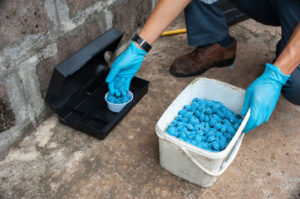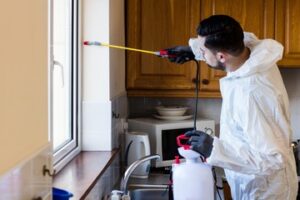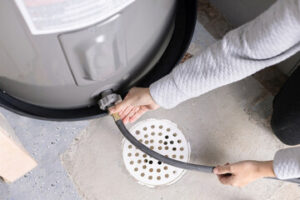Pest control is the set of activities undertaken to minimize damage from insects, weeds, or other organisms that threaten plants and crops. This involves monitoring, threshold-based decision-making and preventive actions.

Identifying the pest is the first step in developing an effective control strategy. Correct identification allows you to determine basic information about the pest, including its life cycle and the time when it is most vulnerable to being controlled. Get in touch with Pest Control Meridian ID for professional support.
Pests are problematic in many ways, from destroying crops to creating health hazards. Pest treatment strategies are typically categorized as preventive or reactive. Preventive methods focus on preventing pests from entering a space or building, while reactive treatments are the more immediate response to an existing infestation. Typical preventive measures include inspection, cleaning and trapping. Food and beverage plants can use these prevention measures to protect their products from adulteration caused by pests, including rodent droppings that carry Salmonella bacteria, and mosquitoes, which can spread diseases such as malaria.
Preventive measures can include physical barriers, such as screens, traps and barrier installation. The removal of food, water and shelter also can reduce the attractiveness of a space to pests. Cleaning and storage practices, such as keeping food in tightly closed containers and storing waste properly, can also be preventive control methods.
There are natural forces that affect all organisms, including pests, causing their populations to rise or fall. Climate, for instance, influences pests’ activity, the growth of their host plants and their ability to reproduce. Biological controls such as predatory species, parasitic insects and pathogens can help suppress pest numbers. These are not considered to be eradication methods, however, because the degree of control often fluctuates.
Chemical pesticides can destroy or at least significantly reduce the population of targeted organisms. These can be effective, but they usually require repeated applications and can have a negative impact on the surrounding environment. Choosing the right pesticide for a situation and following label instructions carefully are essential. Pesticides often have a systemic effect, meaning that they enter the body of the treated organism and are carried throughout its systems. Occasionally, non-target organisms may be harmed by this.
Treatment sites shared by people, pets and other animals, as well as the non-living environment, must be taken into consideration when implementing any type of pest control strategy. All of these organisms may affect the actions of pests, and their interactions can be complicated. Therefore, care must be taken to ensure that the application of any pest control technique does not have unintended consequences.
Suppression
Pests can spread diseases, contaminate food and cause damage to property. There are a number of ways to control pests, from using baits and traps to spraying and dusting. Different methods are more effective against different types of pests. Pest control companies usually have a range of methods that they can use and will often combine several methods to control a single infestation.
The goal of suppression is to reduce the population of the pest to a level that does not threaten the desired outcome. It is an important part of hygiene management, especially in retail and hospitality environments. Despite legislation and strict hygiene guidance, pests can still be a problem in these kinds of settings.
This may involve releasing the pest’s natural enemies, such as parasites or predators, into an area to manage the pest population. It may also involve altering the environment, such as adding mulch to inhibit weed growth or placing netting over plants to prevent insects from damaging them. This type of control is not always successful, and the degree to which it is successful varies depending on the timing of releases, the ability of enemies to find the pest, and the interaction between enemies (e.g., competition for resources or intraguild predation).
Devices that physically prevent pests from entering an area are called physical barriers. They include traps, screens, fences, netting, and barriers such as doors and windows. Changing the amount of available water or light can also help to prevent the invasion of some pests.
Chemicals that are used to kill or repel pests are known as chemical controls. This is one of the most common forms of pest control and can be very effective in some situations. It is a good idea to hire a professional to apply these chemicals because of the potential health risks and the need for safety precautions.
There are a number of other ways to discourage pests, such as making sure that all foods are stored in containers that cannot be easily accessed by pests and removing garbage regularly. It is also a good idea to fix leaky plumbing and keep garbage cans tightly closed. Keeping a clean and hygienic environment can also help to deter pests, as can fitting pest screens on doors and windows.
Eradication
Eradication involves eliminating a pest from an area. It can be accomplished by applying phytosanitary measures in and around an infested area (FDA, 2005). It is similar to suppression but differs in that the goal of suppression is to keep the population below a level where economic injury is acceptable.
The word eradicate originally meant “pull up or out by the roots, extirpate, remove completely.” In modern usage, however, it often refers to the elimination of an organism in an area or management unit. This type of control may be achieved through natural or cultural means or by genetic modification.
Generally, eradication is the last resort for outdoor pest situations. Instead, it is usually the goal for indoor environments, such as greenhouses, nurseries, and processing facilities. Eradication is more common in enclosed areas because the environment can be more easily controlled and harmful insects can be killed by biological controls.
When the decision to eradicate is made, it must be based on an accurate identification of the pest and its life cycle, so that appropriate control methods can be applied. Accurate identification can be done by trained personnel using a microscope or a magnifying lens, by observation at the field site, or with an image obtained from a digital camera or other device.
The most common reason for failure of eradication attempts is a lack of political or public support, which tends to decrease with the duration of an effort. This is especially true for eradications targeting social species, such as ants and wasps (Formicidae), or bees and hornets (Hymenoptera).
In order to reduce costs and minimize harm to the environment and human health, any agrochemical used in the control of pests should be applied only by qualified and properly prepared workers, wearing protective clothing. This includes wearing long pants, closed-toe shoes, a face mask and gloves, and head protection. In addition, all pesticides should be used only when a pest is causing damage and should be applied according to the label. Otherwise, the agrochemical can cause damage to the environment and human health, as well as residue contamination in products.
Monitoring
Managing pests in the long run means monitoring their presence and accurately identifying them. When the need for control arises, IPM programs first evaluate whether the pests have reached an action threshold—the point at which pest numbers or environmental conditions indicate that action must be taken to prevent unacceptable damage or harm. This eliminates the potential for unnecessary use of pesticides, and it helps ensure that any chemicals used are effective and appropriate.
IPM also works to prevent pests by using cultural and biological controls, such as crop rotation, planting resistant varieties, or altering farming practices that may influence weed or disease problems. These methods are much less risky than chemical control options and provide an ecological approach to pest management that is often more cost-effective than conventional pesticides.
In some situations, it may be necessary to treat a crop, building or outdoor space immediately to protect people, pets or property. For example, health and safety codes may dictate that pests be controlled in operating rooms and other sterile areas of hospitals. Regulatory authorities may also mandate that certain pests be controlled to meet food safety requirements.
Regular scouting is an essential component of a good pest monitoring program. This process involves searching for pests in the field, in buildings or other spaces and documenting observations on a log. Depending on the situation, this log can be as low-tech as a piece of paper with tick marks or a spreadsheet with notes for each trap, weed patch, or plant sample.
Observations should include the identity of the pest, the number and location of the observed organisms, and other relevant information. Spreadsheets and a mobile phone app make this data collection easy. Creating and maintaining a pest log allows for tracking patterns of pest activity, such as hotspots, so that the most effective monitoring tactics can be employed.
IPM programs also utilize knowledge-based tools, such as phenology calendars and degree-day models, to help predict the timing of pest development and guide preventive or suppression strategies. These tools account for the fact that some insects, such as aphids, mites and nematodes, develop faster in warm temperatures, while other organisms, such as fungi and weeds, grow more slowly.

